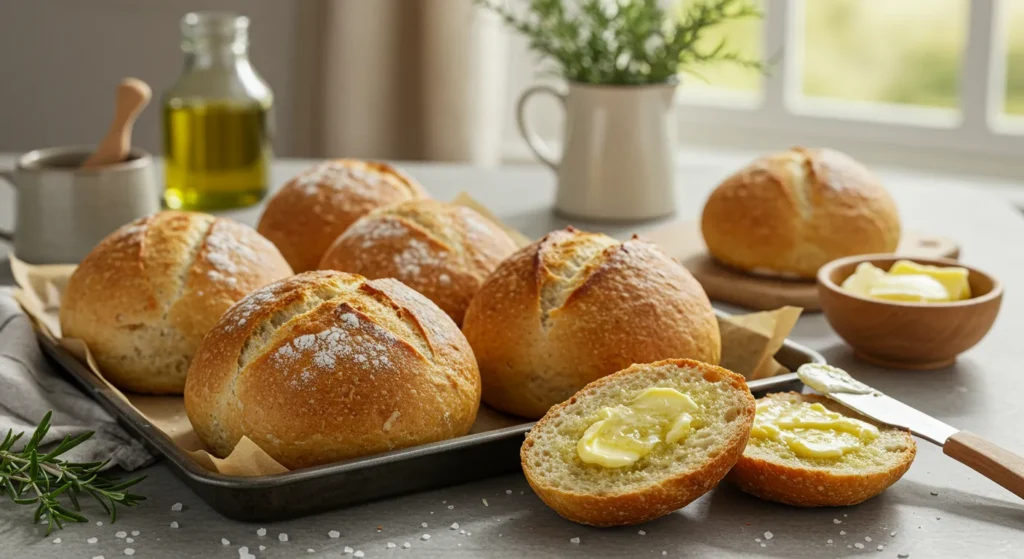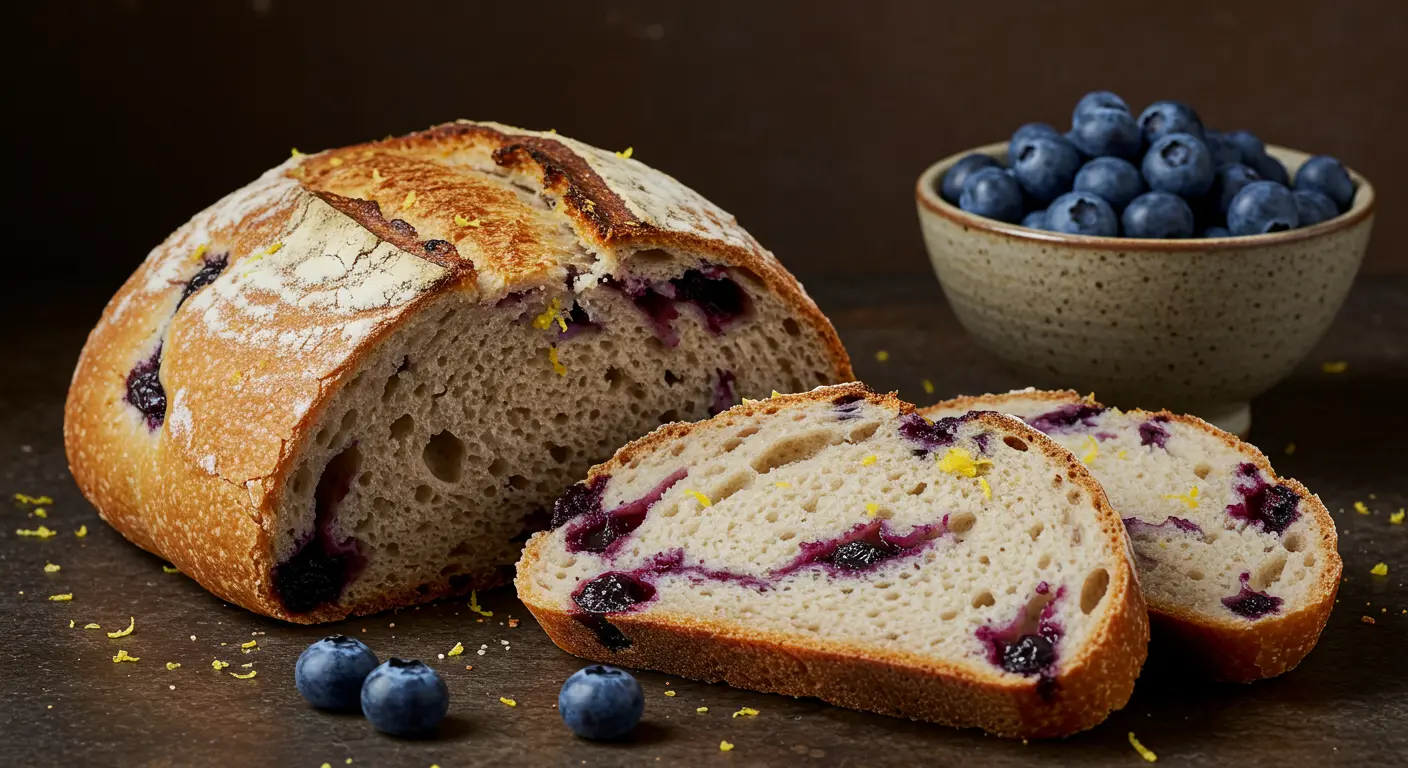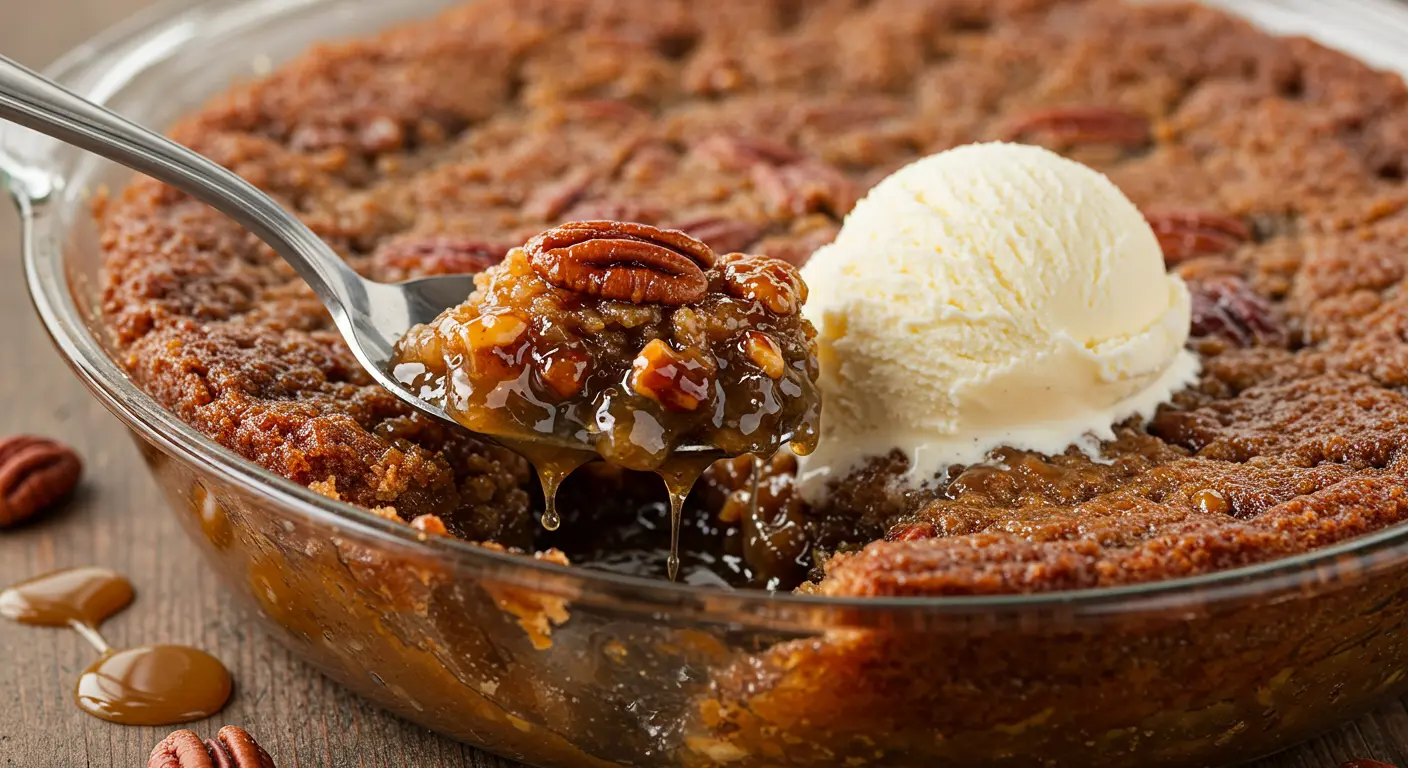There’s something undeniably comforting about the smell of freshly baked bread wafting through your home, and this sourdough bread rolls recipe is sure to bring that warm, cozy feeling to your kitchen. These soft, fluffy rolls are perfect for family dinners, holiday feasts, or even as a snack with a smear of butter.
Sourdough bread has a rich history, with its origins tracing back to ancient Egypt. What makes sourdough unique is its use of a natural starter instead of commercial yeast, which adds a distinct tangy flavor and a tender texture. These sourdough dinner rolls are a delightful twist on the classic loaf, offering a portion-perfect treat that’s as versatile as it is delicious.
This recipe works wonderfully because it balances tradition with simplicity. You can even use your sourdough discard to create these rolls, minimizing waste while maximizing flavor. Whether you’re a seasoned sourdough baker or just getting started, these quick sourdough rolls are easy to make and deliver a bakery-quality experience right in your home.
From their golden, pillowy exterior to the soft, airy crumb inside, these easy sourdough rolls will quickly become a household favorite. Stick around to learn how to master this recipe, explore tips for achieving the perfect rise, and discover creative ways to make these rolls uniquely your own.
Quick Recipe Card
Prep Time:
- Active: 25 minutes
- Rise Time: 4-6 hours (or overnight)
Cook Time:
- 20-25 minutes
Total Time:
- Approximately 6.5 hours
Difficulty:
- Medium
Servings:
- 12 sourdough bread rolls
Nutritional Information (Per Roll):
- Calories: 130
- Protein: 4g
- Fat: 2g
- Carbohydrates: 25g
- Fiber: 1g
Equipment Needed:
- Mixing bowls
- Kitchen scale
- Bench scraper
- Baking sheet or cast iron skillet
- Damp cloth
Ingredients:
- 1 cup (240 ml) active sourdough starter
- 1/2 cup (120 ml) sourdough discard (optional)
- 3 1/2 cups (420 g) bread flour
- 1 cup (240 ml) warm water
- 1/4 cup (60 g) unsalted butter, melted
- 2 tbsp sugar
- 1 tsp salt
Instructions:
- Mix the active sourdough starter, optional sourdough discard, water, sugar, and melted butter in a large bowl.
- Gradually add the bread flour and salt, kneading until a smooth dough forms.
- Cover with a damp cloth and let rise for 4-6 hours or overnight.
- Divide the dough into 12 pieces, shape into rolls, and place on a greased baking sheet.
- Allow the rolls to proof for 1-2 hours until puffy.
- Bake at 375°F (190°C) for 20-25 minutes, or until golden brown.
This sourdough bread rolls recipe is as satisfying to make as it is to eat! These easy sourdough rolls are perfect for any meal, and the addition of sourdough discard rolls ensures no part of your starter goes to waste.
Ingredients Deep Dive
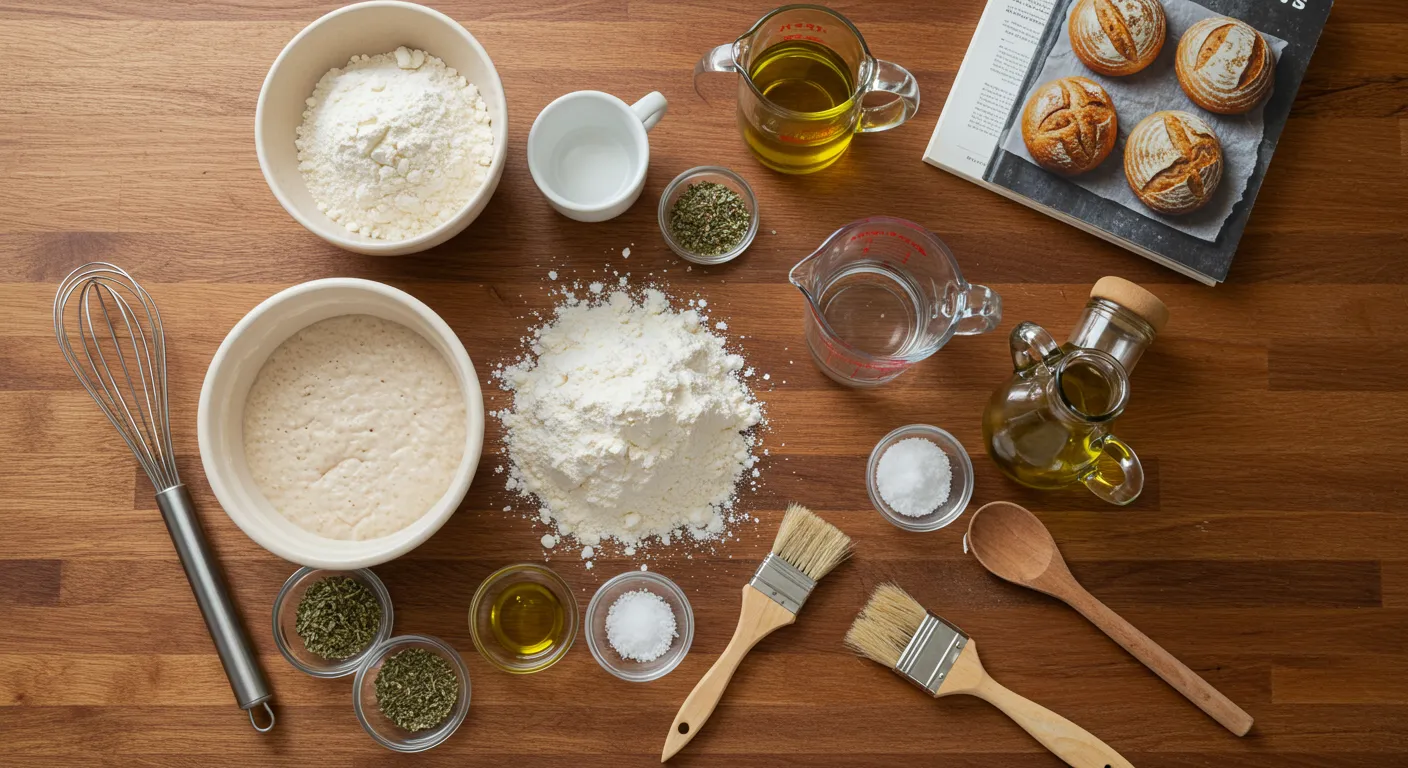
Crafting the perfect sourdough bread rolls recipe starts with understanding the ingredients. Each component plays a crucial role in achieving the soft texture, tangy flavor, and golden crust that makes these rolls irresistible.
Sourdough Starter
The heart of any sourdough recipe is the starter. Using a bubbly, active sourdough starter ensures your rolls have the perfect rise and a slightly tangy taste. If you have leftover sourdough discard, don’t throw it away—it adds depth of flavor and helps reduce food waste when incorporated into the dough.
- Pro Tip: Feed your starter 4-6 hours before baking for the best results.
Bread Flour
Bread flour’s higher protein content is essential for creating rolls with structure and chewiness. All-purpose flour can be used in a pinch, but for that bakery-style texture, stick with bread flour.
- Substitutions: For a heartier flavor, swap 1/2 cup of bread flour with whole wheat flour.
Warm Water
The right temperature (about 100°F or 38°C) activates your starter and ensures a smooth dough. Avoid hot water, which can kill the natural yeast in your starter.
Unsalted Butter
Butter adds richness and a tender crumb to the sourdough dinner rolls. Melted butter is easier to incorporate into the dough.
- Substitutions: Use coconut oil or olive oil for a dairy-free alternative.
Sugar
A small amount of sugar enhances the flavor and feeds the natural yeast. While not necessary for fermentation, it does help achieve that golden crust.
- Variations: Swap sugar for honey or maple syrup for a more natural sweetness.
Salt
Salt is a key ingredient for controlling the fermentation process and enhancing the flavor of these easy sourdough rolls. Add it after mixing the starter and flour to avoid inhibiting the yeast activity.
Storage Tips for Ingredients
- Keep your starter in the fridge if not baking frequently, feeding it weekly to maintain its activity.
- Store bread flour in an airtight container to prevent moisture absorption.
- Always use fresh butter and check your salt and sugar for clumping if stored in humid environments.
By understanding the role of each ingredient, you’ll master this quick sourdough rolls recipe with ease. Plus, incorporating sourdough discard rolls into your baking routine reduces waste and enhances the flavor.
Equipment Needed
To create the perfect sourdough bread rolls recipe, having the right tools can make a world of difference. Here’s a list of essential and alternative equipment to help you bake with ease:
Essential Tools
- Mixing Bowls
- At least two large bowls are needed: one for mixing the dough and another for proofing. Glass or stainless steel bowls work best.
- Kitchen Scale
- Accurate measurements are crucial in sourdough baking. A kitchen scale ensures precision, especially when working with ingredients like bread flour and starter.
- Bench Scraper
- This versatile tool is perfect for dividing the dough into equal portions for your sourdough dinner rolls and shaping them.
- Baking Sheet or Cast Iron Skillet
- A greased baking sheet or a cast iron skillet provides even heat distribution for a golden crust.
- Damp Cloth or Plastic Wrap
- Covering the dough during proofing prevents it from drying out and ensures optimal fermentation.
Alternative Options
- Measuring Cups and Spoons: If you don’t have a kitchen scale, these can work in a pinch, though they’re less precise.
- Dutch Oven: Great for baking rolls if you want a more artisanal crust.
Care and Maintenance Tips
- Keep your bench scraper clean to avoid dough sticking.
- Season your cast iron skillet regularly to maintain its non-stick surface.
Budget vs. Premium Options
- Budget: Opt for affordable mixing bowls and measuring tools from your local store.
- Premium: High-quality brands like Le Creuset or KitchenAid offer durable tools that last a lifetime.
With these tools in hand, you’re ready to tackle this quick sourdough rolls recipe or even experiment with sourdough discard rolls.
Step-by-Step Instructions
Crafting this sourdough bread rolls recipe is a rewarding process that fills your kitchen with the comforting aroma of freshly baked bread. Follow these detailed steps to ensure success:
Step 1: Prepare the Dough
- In a large mixing bowl, combine 1 cup (240g) of active sourdough starter, 3 cups (360g) of bread flour, 1/2 cup (120ml) of warm water, 1/4 cup (50g) sugar, and 1/2 teaspoon salt.
- Mix the ingredients until a rough dough forms. Add 2 tablespoons (30g) of melted butter and knead it into the dough.
- Knead by hand for about 8-10 minutes or use a stand mixer with a dough hook for 5-6 minutes until the dough becomes smooth and elastic.
Step 2: First Proofing
- Place the dough in a greased bowl and cover it with a damp cloth or plastic wrap.
- Let it proof in a warm spot for 3-4 hours until it doubles in size. The natural yeast in the sourdough starter will create air pockets that make your rolls light and fluffy.
Step 3: Shaping the Rolls
- Lightly flour your work surface and turn out the dough.
- Use a bench scraper to divide the dough into 12 equal pieces for standard rolls or 6-8 pieces for larger ones.
- Shape each piece into a ball by tucking the edges underneath and rolling it gently on the surface.
Step 4: Second Proofing
- Arrange the shaped rolls on a greased baking sheet or cast iron skillet, leaving about 1 inch (2.5 cm) of space between each roll.
- Cover the rolls loosely with a damp cloth and allow them to proof for another 1-2 hours until they puff up slightly.
Step 5: Baking the Rolls
- Preheat your oven to 375°F (190°C).
- Brush the tops of the rolls with melted butter or a milk wash for a shiny, golden finish.
- Bake for 20-25 minutes or until the rolls are golden brown and sound hollow when tapped on the bottom.
Step 6: Cooling and Serving
- Remove the rolls from the oven and let them cool on a wire rack for at least 10 minutes before serving.
- Enjoy them warm as a side for soups or with a slather of butter for a simple snack.
Common Pitfalls and How to Avoid Them
- Dough Too Sticky: Add a tablespoon of flour at a time while kneading until the dough is workable.
- Dense Rolls: Ensure your sourdough starter is active and bubbly before using it.
- Uneven Shaping: Use a kitchen scale to weigh each dough piece for uniform rolls.
Timing Tips
- For a more pronounced sourdough flavor, refrigerate the dough during the first proofing for 12-24 hours.
- If short on time, use the warm proofing method: Place the bowl of dough in a slightly warm oven (about 80°F or 27°C).
These detailed instructions make it easy to master this sourdough bread rolls recipe while avoiding common mistakes. You’ll love the soft, tangy rolls that pair beautifully with any meal!
Expert Tips and Tricks
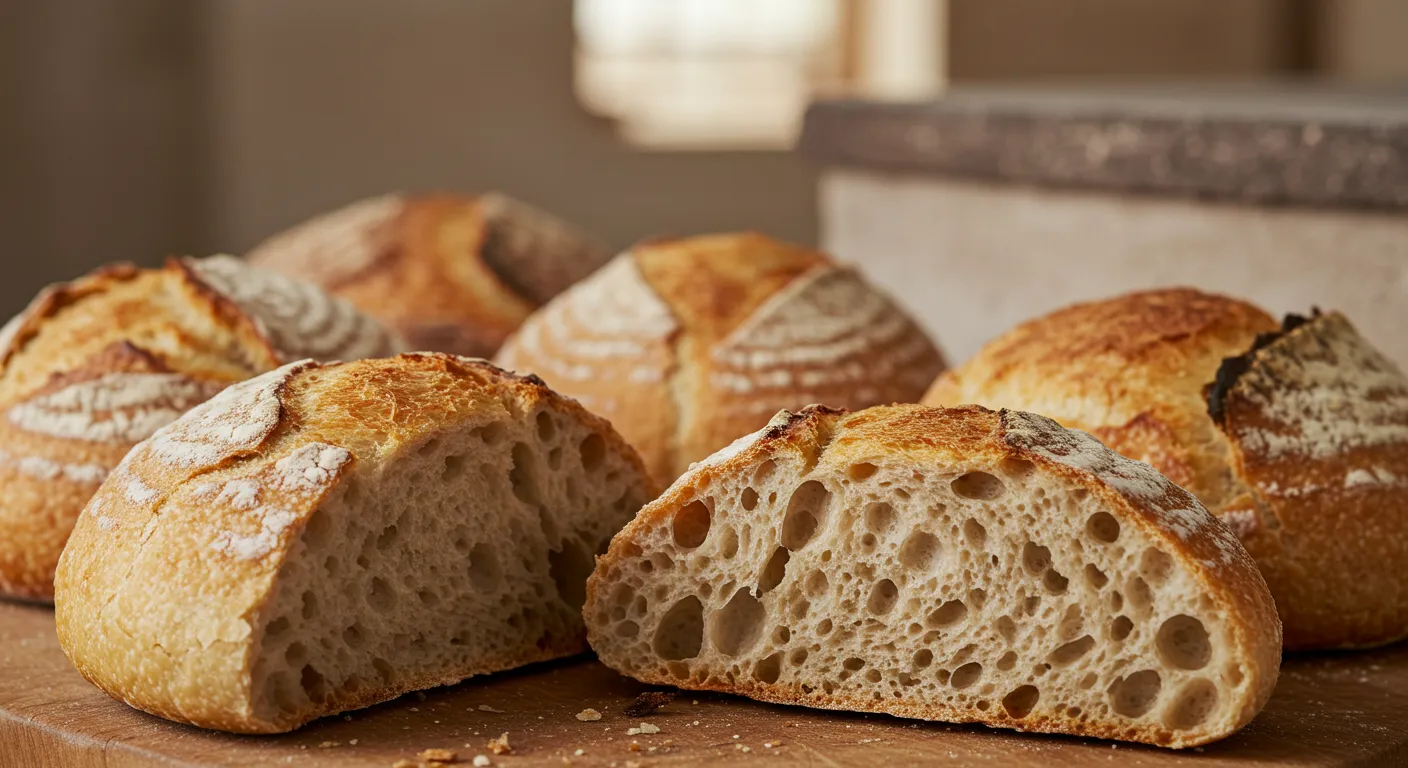
To perfect your sourdough bread rolls recipe, follow these expert tips that will elevate your baking game while seamlessly incorporating the keywords:
Professional Baker Insights
- Feed Your Starter Regularly: Ensure your sourdough starter is active and fed at least 6-8 hours before using it in this sourdough bread rolls recipe for the best rise and flavor.
- Balance Hydration: Dough consistency is crucial. If it’s too dry, add a teaspoon of water at a time; if it’s too sticky, sprinkle in a little flour.
Troubleshooting Common Issues
- Flat Rolls: If your sourdough dinner rolls spread instead of rising, the dough might be underproofed. Allow more time during the first proofing stage.
- Overly Tangy Flavor: For a milder taste, use your starter right after feeding, as it’s less sour at this stage.
Make-Ahead Instructions
- Refrigerated Proofing: For added convenience and flavor depth, refrigerate the dough during the first proofing for up to 24 hours.
- Freezing Dough: Shape the rolls and freeze them on a tray. Once frozen, store them in an airtight bag. When ready to bake, thaw, proof, and proceed as usual.
Storage Guidelines
- Room Temperature: Store baked sourdough bread rolls in an airtight container for up to 2 days.
- Freezing Baked Rolls: Cool the rolls completely, wrap them tightly in foil, and freeze for up to 3 months. To reheat, thaw and warm them in an oven at 300°F (150°C).
Incorporating these expert tips ensures your quick sourdough rolls recipe yields soft, flavorful rolls every time. Whether you’re making sourdough discard rolls or opting for a faster method, these techniques set you up for success.
Variations and Customizations
Bring a personal touch to your sourdough bread rolls recipe with these creative variations and customizations. Each tweak adds a unique flavor profile or adapts the recipe for dietary needs, ensuring there’s a roll for every occasion.
Seasonal Adaptations
- Herb-Infused Rolls: Add 2 teaspoons of dried rosemary, thyme, or sage to the dough for a festive touch perfect for holiday dinners.
- Pumpkin Sourdough Rolls: Incorporate ½ cup of pumpkin purée to the dough for an autumnal twist.
Dietary Modifications
- Gluten-Free Sourdough Rolls: Use a gluten-free sourdough starter and replace all-purpose flour with a gluten-free flour blend.
- Low-Sodium Rolls: Reduce the salt content in the dough without sacrificing texture by adding fresh herbs for flavor.
Flavor Variations
- Cheesy Rolls: Fold ½ cup of grated cheddar, Parmesan, or Gruyère into the dough before shaping.
- Garlic Butter Topping: Brush the rolls with melted garlic butter as soon as they come out of the oven for a savory twist.
Decoration Ideas
- Seeded Toppings: Sprinkle sesame seeds, poppy seeds, or everything bagel seasoning on top before baking.
- Rustic Scoring: Lightly score the tops of the rolls with a sharp blade to create a decorative finish.
Experimenting with these customizations transforms your sourdough bread rolls recipe into a versatile masterpiece. Whether you’re craving easy sourdough rolls or exploring a festive quick sourdough rolls recipe, these ideas make baking fun and personalized.
Serving and Presentation
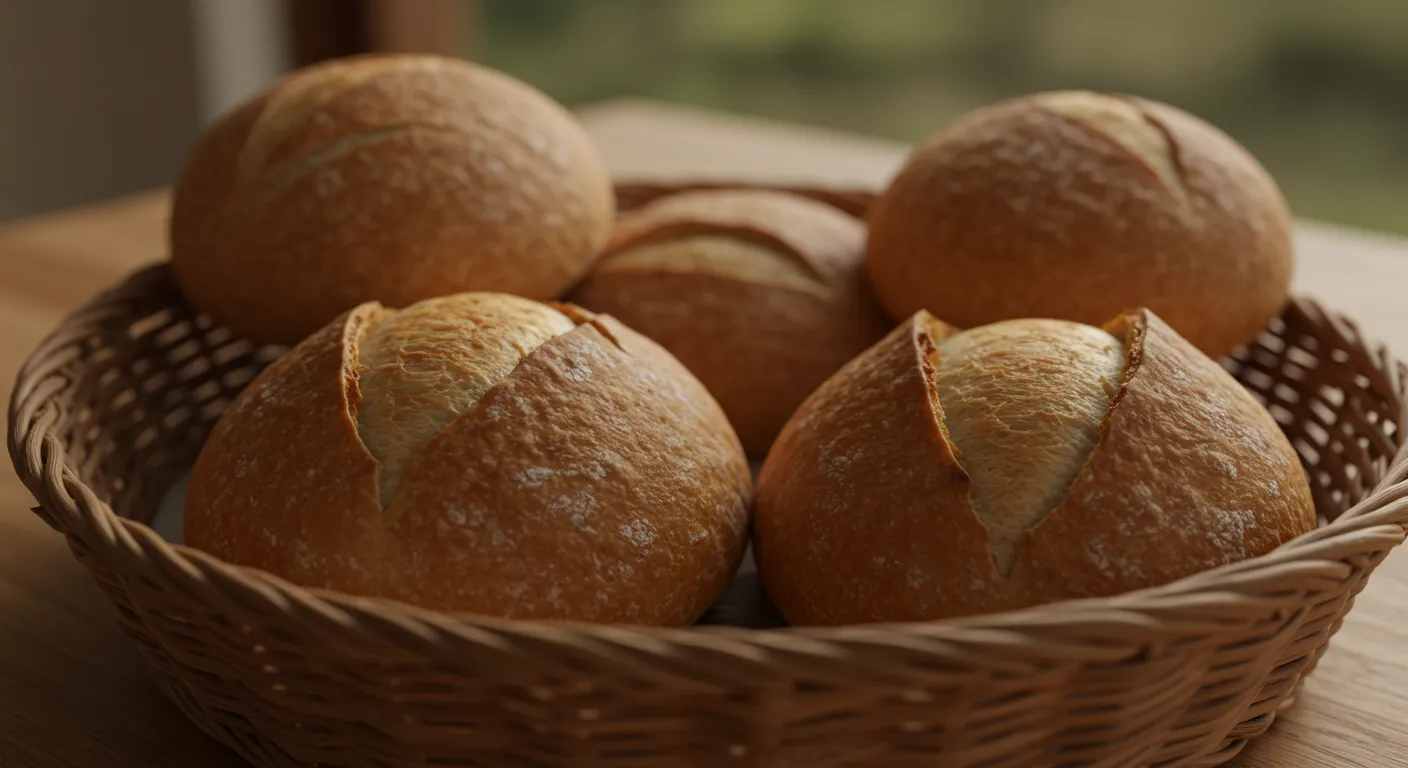
Presentation is key when showcasing your sourdough bread rolls recipe. Here are some ideas to elevate their appeal and enhance the dining experience.
Plating Suggestions
- Basket Display: Serve the sourdough dinner rolls in a rustic wicker basket lined with a linen cloth for a warm, homey touch.
- Tiered Serving Stand: Arrange rolls on a tiered stand for an elegant brunch or dinner table centerpiece
Accompaniment Recommendations
- Butter Trio: Pair rolls with flavored butters like garlic herb, honey cinnamon, or truffle-infused for a gourmet experience.
- Dips and Spreads: Offer a side of creamy spinach dip, hummus, or whipped feta for variety.
Special Occasion Presentations
- Holiday Wreath: Arrange the rolls in a circular pattern on a baking sheet, leaving space in the center. Bake and garnish with fresh rosemary sprigs and cranberries for a festive wreath.
- Mini Roll Bites: Divide dough into smaller portions to create bite-sized rolls, perfect for cocktail parties or appetizers.
Photography Tips for Social Sharing
- Lighting: Use natural light near a window to highlight the golden crust of your quick sourdough rolls recipe.
- Close-Ups: Capture the fluffy interior with a slice or a broken roll to emphasize texture.
- Props: Add a wooden cutting board, a small butter knife, or fresh herbs to enhance the visual storytelling.
Pair these sourdough bread rolls with soups, stews, or salads for a complete meal.
Conclusion
There’s nothing quite like the aroma of fresh sourdough bread rolls wafting through your home. Whether you’re baking up a batch of sourdough discard rolls, trying an easy sourdough rolls recipe, or crafting sourdough dinner rolls for a special occasion, this recipe offers the perfect balance of tangy flavor and soft texture. With a few expert tips and creative customizations, your rolls will be the star of any meal, from cozy weeknight dinners to festive gatherings.
As you perfect your sourdough bread rolls recipe, remember that the journey is just as enjoyable as the end result. The beauty of this recipe lies in its versatility—whether you’re in the mood for classic, buttery rolls or experimenting with herbs and flavors, you have the flexibility to make it your own.
So, gather your ingredients, roll up your sleeves, and savor the delightful process of creating the perfect sourdough rolls. Enjoy them fresh out of the oven or stored for later, and be ready to impress family and friends with your homemade bread.
Happy baking, and don’t forget to share your sourdough bread rolls creations with those who’ll appreciate the love and effort you put into every bite!
FAQ Section
1. Can I use regular yeast instead of sourdough starter for this recipe?
Yes, you can substitute regular active dry yeast for the sourdough starter. However, the flavor and texture will be different. You’ll need to adjust the recipe by adding about 2 teaspoons of yeast and reducing the fermentation time.
2. How can I store leftover sourdough bread rolls?
Store leftover rolls in an airtight container at room temperature for up to 3 days. If you want to keep them fresh for longer, you can freeze them for up to 3 months. Just reheat them in the oven to restore their fluffy texture.
3. How do I make sourdough discard rolls with my leftover starter?
To make sourdough discard rolls, simply replace the sourdough starter in the recipe with your discarded starter. Follow the same steps for the dough, and you’ll have delicious rolls without wasting your starter!
4. Can I add other flavors like garlic or cheese to this sourdough bread rolls recipe?
Yes! You can mix in grated cheese, herbs like rosemary or thyme, or roasted garlic to customize your rolls. Just fold them into the dough during the final mixing stage.
5. How long should I let the dough rise before baking?
For the best results, let the dough rise for about 1-2 hours, or until it doubles in size. If you’re using a sourdough starter, the rise time can vary depending on the starter’s strength. A longer rise will enhance the flavor.
6. Can I use quick sourdough rolls recipe instead of the traditional method for faster results?
Yes, a quick sourdough rolls recipe can be used for faster results, though the flavor may be less complex. These rolls don’t require the long fermentation time of traditional sourdough but still provide delicious, soft results.

